FRIDAY, OCTOBER 2
■ Moon and Mars. The Moon this evening, a day past full, rises in mid-twilight with bright Mars by its side! After dark they make a striking pair, only 1° or 2° apart for North Americans. Think photo opportunity.
Later in the night, watch as they slowly draw farther apart. Although they look like companions, Mars tonight is 155 times farther away than the Moon. And although Mars looks tiny, it's twice the Moon's diameter.
The Moon will actually occult Mars for parts of southern South America; map and details.
■ Before and during early dawn Saturday, Regulus will be snuggling 0.6° above Venus (at dawn for North America) as sh0wn below. That's about the width of a pencil held at arm's length.
Regulus, even though it's 1st magnitude, is less than a hundredth as bright as Venus, magnitude –4.1. So look early while the sky is still pretty dark. Closer to sunrise use binoculars or, better, a telescope (at no more than about 75 power).
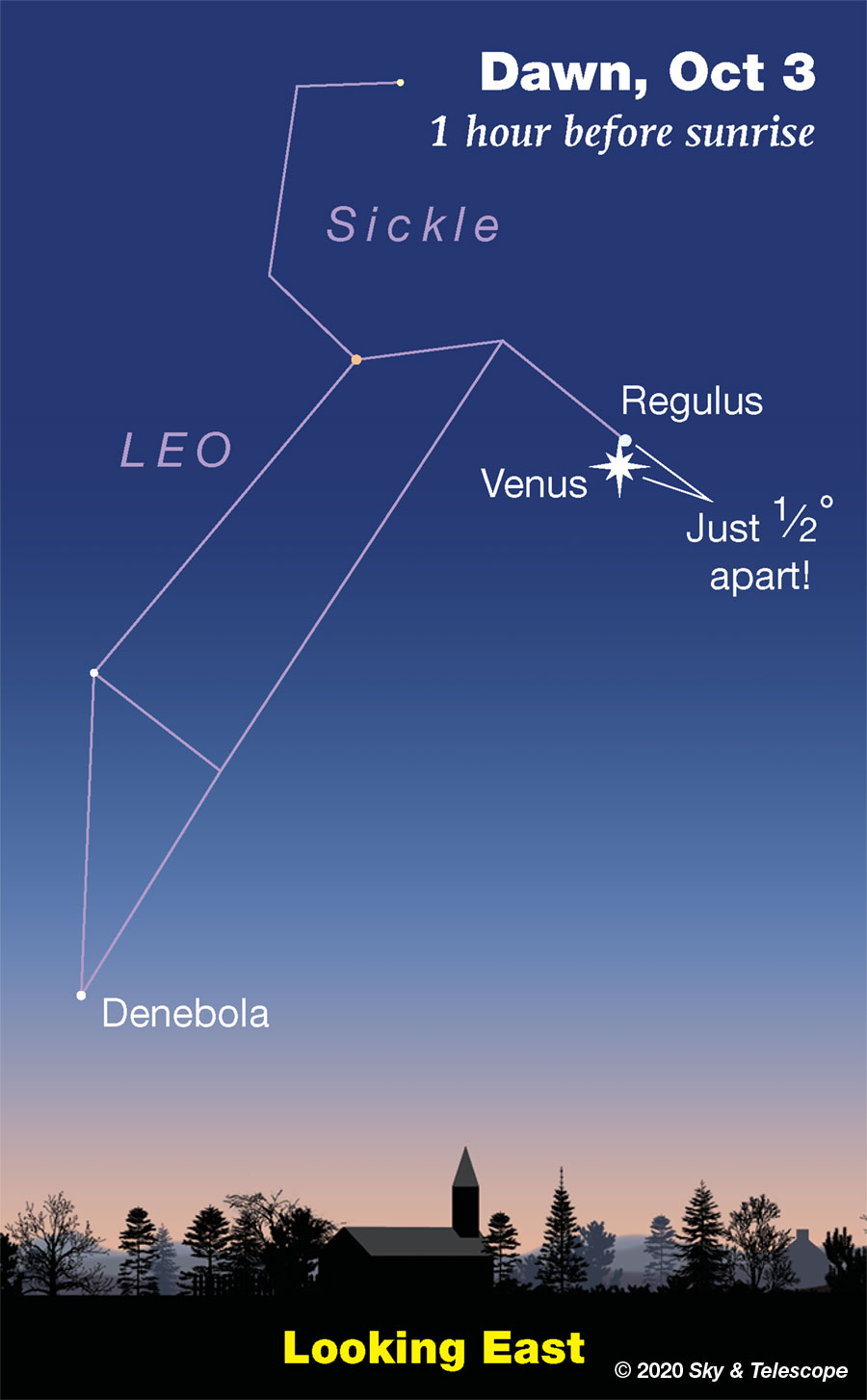
SATURDAY, OCTOBER 3
■ Now the Moon rises near the end of twilight, with Mars blazing brightly about a fist at arm's length to its upper right.
■ With fall well under way, Algol is well up in the northeast after dark. Normally it shines at magnitude 2.1, but this evening it goes through one of its periodic self-eclipses: It should be as faint as magnitude 3.4 for a couple hours centered on 9:48 p.m. EDT. Algol takes several additional hours to fade and to rebrighten.
Compare it to Gamma Andromedae, magnitude 2.1, about a fist at arm's length to its upper right. And see Bob King's When Algol Winks, Will You Wink Back?
SUNDAY, OCTOBER 4
■ Arcturus shines low in the west these evenings as twilight fades out. Capella, equally bright, is lower in the north-northeast (depending on your latitude; the farther north you are the higher it will be.) They're both magnitude 0.
Not long after full dark, Arcturus and Capella shine at the same height. When will this happen? That depends on both your latitude and longitude.
When it does, turn around and look low in the south-southeast. There will be 1st-magnitude Fomalhaut at the same height too — if you're at latitude 43° north (Boston, Buffalo, Milwaukee, Boise, Eugene). Seen from south of that latitude, Fomalhaut will appear higher than Capella and Arcturus are. Seen from north of there, it will be lower.
■ Jupiter's Great Red Spot should transit the planet's central meridian around 9:24 p.m. Eastern Daylight Time.
MONDAY, OCTOBER 5
■ By 10 p.m. tonight (daylight-saving time) the waning gibbous Moon is up in the east. Look upper left of it for the Pleiades and lower left of it for orange Aldebaran.
TUESDAY, OCTOBER 6
■ This is the exact date when Mars is closest to Earth: 0.415 a.u (38.6 million miles; 3.5 light-minutes). It won't pass us that close again until September 2035. How old will you be then?
■ Vega is the brightest star very high in the west at nightfall, almost overhead. Arcturus, equally bright, is getting low in the west-northwest. The brightest star in the vast expanse between them, about a third of the way from Arcturus up toward Vega, is Alphecca, magnitude 2.2 — the crown jewel of Corona Borealis. Alphecca is a 17-day eclipsing binary, but its brightness dips are too slight for the eye to see reliably.
■ Jupiter's Great Red Spot should transit Jupiter's central meridian around 11:03 p.m. EDT.
WEDNESDAY, OCTOBER 7
■ The starry W of Cassiopeia stands high in the northeast these evenings, nearly on end. Look along the second segment of the W counting down from the top. Notice the dim naked-eye stars along that segment (not counting its two ends). The brightest of these, on the right, is Eta Cassiopeiae, magnitude 3.4. It's a remarkably Sun-like star just 19 light-years away, and it has a distant orange-dwarf companion, magnitude 7.3. They're a lovely binary in a telescope.
The next "one" down the segment, fainter, is a naked-eye pair in a dark sky: Upsilon1 and Upsilon2 Cassiopeiae, 0.3° apart. They're yellow-orange giants unrelated to each other, 200 and 400 light-years distant. Upsilon1 is slightly fainter; that's the farther one.
THURSDAY, OCTOBER 8
■ Vega is the brightest star very high in the west these evenings. To its lower right by 14° (nearly a fist and a half at arm's length) is Eltanin, the orange nose of Draco the Dragon. The rest of Draco's fainter, lozenge-shaped head is a little farther behind. Draco always eyes Vega as they wheel around the sky.
The main stars of Vega's own constellation, Lyra — quite faint by comparison — now extend to its left (by 7°).
FRIDAY, OCTOBER 9
■ Last-quarter Moon (exact at 8:40 p.m. EDT). The Moon rises around 11 or midnight tonight local time. Once it does, look for Pollux a few degrees to its left and Castor above Pollux. Way high above them at that time is Capella. Far to their right, Orion is on the way up.
By dawn Saturday morning the 10th, the Moon stands high in the southeast — with the Gemini twin stars glimmering to its upper left and brighter Procyon farther to its lower right, as shown below.
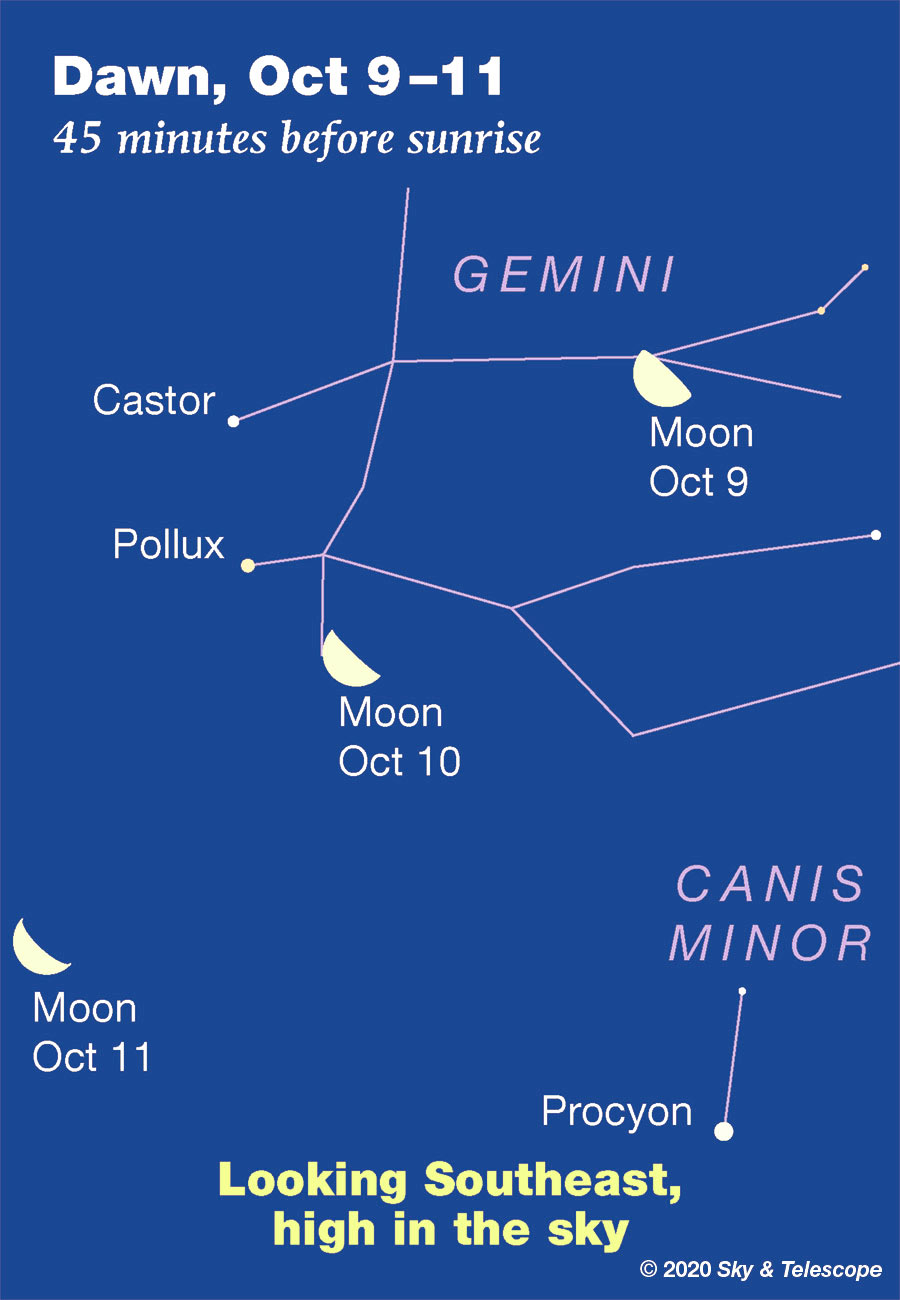
■ Io reappears out of eclipse from Jupiter's shadow around 8:27 p.m. EDT. Watch it slowly glimmer into view a little east of the planet.
Right around that same time, Jupiter's Great Red Spot should be transiting Jupiter's central meridian.
SATURDAY, OCTOBER 10
■ The Great Square of Pegasus balances on its corner high in the east at nightfall. For your location, when it is exactly balanced? That is, when is the Square's top corner exactly above its bottom corner? This will be sometime soon after the end of twilight, depending on your latitude. Try lining up the stars with the vertical edge of a building as a measuring tool. How accurately can you time this event?
This Week's Planet Roundup
Mercury is nearing the end of a very low, poor apparition deep in the sunset. It's still a respectable magnitude 0.0, however, so go ahead and try. Bring binoculars. About 15 minutes after sunset while twilight is still bright, scan for Mercury just above the west-southwest horizon. Good luck.
Venus (magnitude –4.1, in Leo) rises in deep darkness almost two hours before dawn begins, in the east-northeast. By the time dawn gets under way, Venus shines prominently in the east.
While the sky is still dark, spot Regulus above Venus or to its upper right. They separate rapidly this week, from 0.6° apart on the morning of the 3rd to 9° on October 10th.
In a telescope, Venus continues to shrink slowly into the distance; it's now only 15 arcseconds in diameter. And it's growing more gibbous, about 73% sunlit, as it rounds toward passing behind the Sun next winter.
Mars is closest to Earth this week! (It's exactly so on October 6th). And, as Mars visits go, this one is especially close; Mars appears 22.6 arcseconds wide. It won't be as close and big again until September 2035. Mars's opposition comes a week later, on the 13th.
Mars rises in early twilight. As night comes on it glares fiery orange and Jupiter-bright (magnitude –2.5) low in the east. It climbs higher as the hours pass, then blazes at its highest and telescopic best around 1 a.m. daylight-saving time, beaming down from high in the south in Pisces.
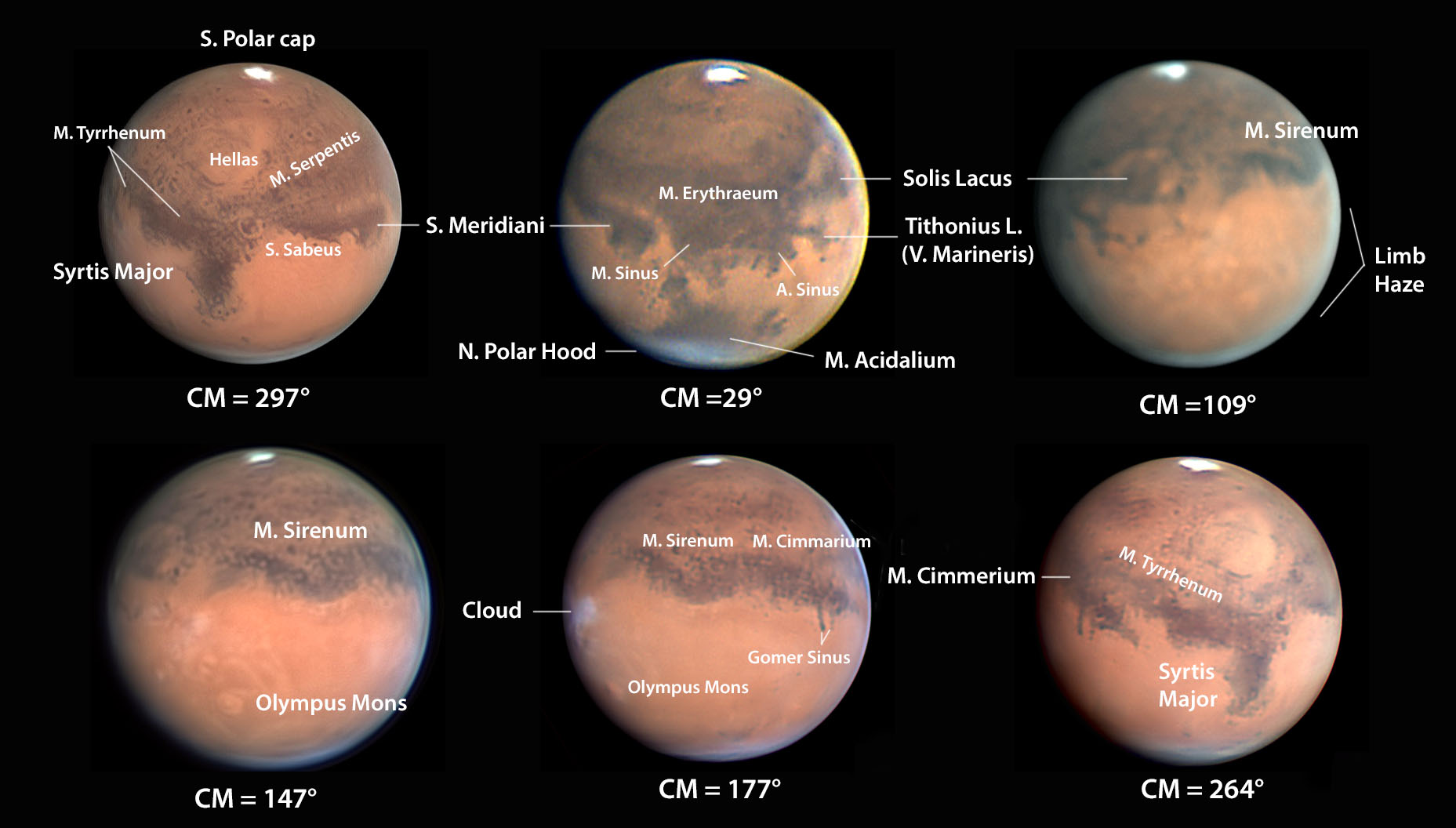
See Bob King's "A Great Year for Mars" in the October Sky & Telescope, page 48, and his Behold Mars! story online. To get a map of the side of Mars facing Earth at the date and time you'll observe, you can use our Mars Profiler. The map there is square; remember to mentally wrap it onto the side of a globe. (Features near the map's edges become very foreshortened.)
Jupiter and Saturn (magnitudes –2.3 and +0.5, respectively) shine in the south during dusk and early evening, then they move to the southwest as evening grows late, tilting as they go.
Jupiter is the bright one; Saturn is 7° to its left. Watch the two planets gradually edge together for the rest of the fall. They will pass just 0.1° from each other at conjunction on December 21st, low in twilight, as fall turns to winter.
Telescopically there's a lot happening on Jupiter now; see Bob King's Stormy Times on Jupiter. And you can follow the interplay of Jupiter with its moons and their shadows, and find the transit times of Jupiter's Great Red Spot, using the Celestial Calendar section of the current Sky & Telescope.
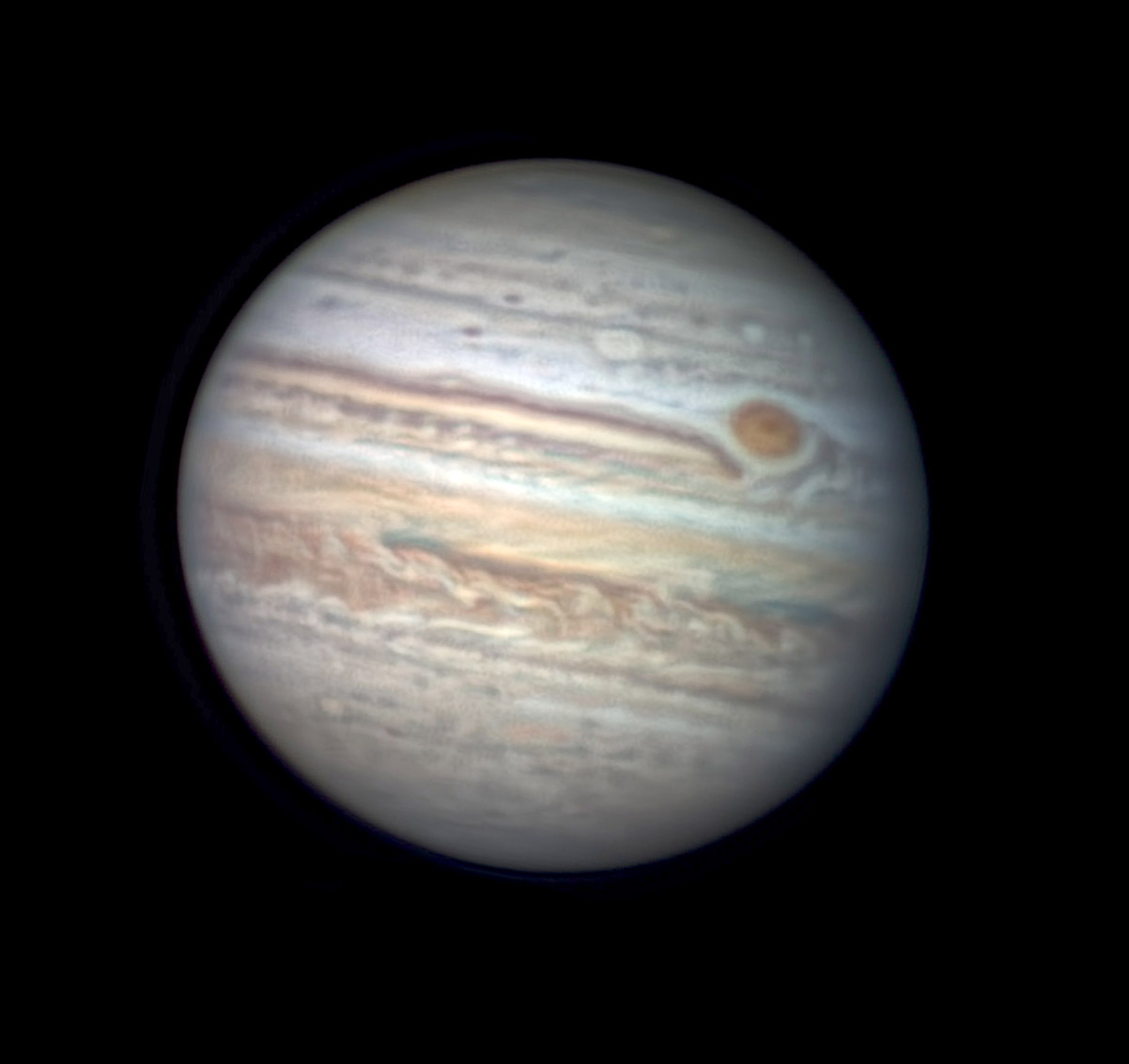
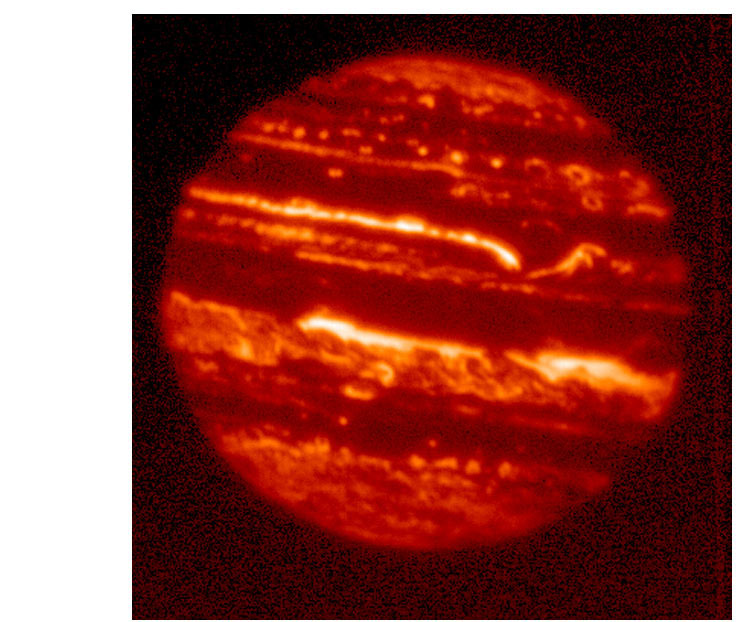
Uranus (magnitude 5.7, in Aries) is fairly well up in the east by 10 p.m. daylight-saving time, about 16° east of Mars. Uranus is only 3.7 arcseconds wide, but that's enough to appear as a tiny fuzzy ball, not a point, at high power in even a small telescope.
Neptune (magnitude 7.8, in Aquarius) is higher in the south-southeast at that time. Neptune is 2.4 arcseconds wide, harder to resolve except in good seeing. Finder charts for Uranus and Neptune.
All descriptions that relate to your horizon — including the words up, down, right, and left — are written for the world's mid-northern latitudes. Descriptions that also depend on longitude (mainly Moon positions) are for North America.
Eastern Daylight Time, EDT, is Universal Time minus 4 hours. (Universal Time is also known as UT, UTC, GMT, or Z time.)
Want to become a better astronomer? Learn your way around the constellations. They're the key to locating everything fainter and deeper to hunt with binoculars or a telescope.
This is an outdoor nature hobby. For an easy-to-use constellation guide covering the whole evening sky, use the big monthly map in the center of each issue of Sky & Telescope, the essential magazine of astronomy.
Once you get a telescope, to put it to good use you'll need a detailed, large-scale sky atlas (set of charts). The basic standard is the Pocket Sky Atlas (in either the original or Jumbo Edition), which shows stars to magnitude 7.6.

Next up is the larger and deeper Sky Atlas 2000.0, plotting stars to magnitude 8.5; nearly three times as many. The next up, once you know your way around, are the even larger Interstellarum atlas (stars to magnitude 9.5) or Uranometria 2000.0 (stars to magnitude 9.75). And be sure to read how to use sky charts with a telescope.
You'll also want a good deep-sky guidebook, such as Sky Atlas 2000.0 Companion by Strong and Sinnott, or the bigger (and illustrated) Night Sky Observer's Guide by Kepple and Sanner.
Can a computerized telescope replace charts? Not for beginners, I don't think, and not on mounts and tripods that are less than top-quality mechanically, meaning heavy and expensive. And as Terence Dickinson and Alan Dyer say in their Backyard Astronomer's Guide, "A full appreciation of the universe cannot come without developing the skills to find things in the sky and understanding how the sky works. This knowledge comes only by spending time under the stars with star maps in hand."
![]() Audio sky tour. Out under the evening sky with your
Audio sky tour. Out under the evening sky with your
earbuds in place, listen to Kelly Beatty's monthly
podcast tour of the heavens above. It's free.
"The dangers of not thinking clearly are much greater now than ever before. It's not that there's something new in our way of thinking, it's that credulous and confused thinking can be much more lethal in ways it was never before."
— Carl Sagan, 1996
"Facts are stubborn things."
— John Adams, 1770
 10
10








Comments
Rod
October 2, 2020 at 10:43 am
mary beth, New Jersey Eclipse Fan. I enjoyed some very good views of Mars the night of 30-Sep using my smaller, 90-mm telescope (fields were very wet - again). 129x to 200x views using green and red filters. Tonight looks like a good weather evening for me. I plan to view the Moon and Mars rising close together tonight in Pisces. 31x view should be able to see some of the Moon and planetary disk shape of Mars in the eyepiece field of view. However, that Moon will be very bright too, near magnitude -12 according to Stellarium and Mars about -2.52. Both objects will be bright and easy to see tonight. Good time at my location will be 10:00 PM - 11:00 PM for easy viewing from my backyard.
You must be logged in to post a comment.
New Jersey Eclipse Fan
October 2, 2020 at 5:18 pm
Make sure not to temporarily blind yourself while viewing the magnified Moon! For Jews, the Pilgrimage Holiday of Sukkot begins at sundown tonight. I look forward to enjoying viewing the Moon/Mars conjunction through the bamboo-thatched roof of my Sukkah! Of course, I could just step outside of it to view it unobstructed, too...
You must be logged in to post a comment.
Rod
October 2, 2020 at 6:15 pm
enjoy the feast ((Moses and the Torah, the feasts are wonderful :)) New Jersey Eclipse Fan. In the telescope view, I will see only a portion of the waning gibbous Moon in order to fit Mars into the same field at about 30x to 40x views. The Moon is bright even in a 90-mm refractor but not so bright like the Sun 🙂 In NJ like my place in MD, you should have very clear skies tonight. So have some time viewing tonight---Rod
You must be logged in to post a comment.
mary beth
October 3, 2020 at 12:06 am
Rod, NJEF, Hope you both are enjoying the gorgeous conjunction. Is this close enough to be considered a conjunction? I know that it’s almost 2° apart in some places and I didn’t know whether it has to be less than a degree to be considered a ‘true’ conjunction. (Seems like I read that years ago on some astronomy website) It is fabulous and so amazing that Mars is not washed out by the bright Harvest moon. I think it is bright enough to be visible through bamboo! Looking forward to observing Mars every day this month. I need to check out Bob King’s column to see how much longer we can enjoy the beauty.
Sounds like all three of us had perfect weather for this! I do hope the fields weren’t too wet to be comfortable and that the telescope mount didn’t get muddy. NJEF, enjoy the festivities!
You must be logged in to post a comment.
Rod
October 3, 2020 at 7:50 am
Ya all 🙂 It was a great evening last night. Shortly after 2100 EDT, I enjoyed observing a rocket launch from NASA Wallops Island, an Antares mission to the ISS. Smartphone had the launch site online while I observed from an overlook area using 10x50 binoculars for six minutes, including seeing the first stage booster separation and second stage burn. I was about 80 miles away but looked like I was there 🙂 I went back to my place and enjoyed the *close conjunction* or nearly so of the Moon and Mars. By 2230 EDT, I could place both into the FOV at 31x. I used a green filter to reduce glare. Aristarchus crater area and lunar limb visible with small, planetary disk of Mars. At 180x using yellow filter, much surface detail visible including the shrinking south polar cap on Mars. Rocket launch, Mars, and Moon observing 🙂
You must be logged in to post a comment.
Tony-Rice
October 4, 2020 at 1:39 pm
I get October 6 as the date of Mars' closest point to Earth (in 2020), specifically 2020-Oct-06 14:13 UTC, rather than October 5 mentioned in the article. Not a big difference observational of course.
You must be logged in to post a comment.
Monica Young
October 5, 2020 at 11:07 am
That is correct, and I've edited the post to reflect this. Thank you!
You must be logged in to post a comment.
Rod
October 5, 2020 at 11:01 pm
I hope folks are getting excellent views of Mars in telescopes now. I am out again this evening and enjoying the views. At 200x, I find #58 Green filter brightens the south polar cap area and #23A Red filter shows much dark surface areas like Syrtis Major. Hellas area visible too, this with a 90-mm refractor. Tomorrow night, I plan to view with my 10-inch Newtonian.
You must be logged in to post a comment.
mary beth
October 6, 2020 at 12:45 am
Clear weather and a beautiful night sky here. You have really had some great experiences this week but I don’t know if anything’s going to be able to top your Oct 2-3 observations!
You must be logged in to post a comment.
Rod
October 6, 2020 at 1:29 pm
Bob King posted his Mars report now at S&T. Looking good here for another Mars night using my 10-inch.
You must be logged in to post a comment.
You must be logged in to post a comment.